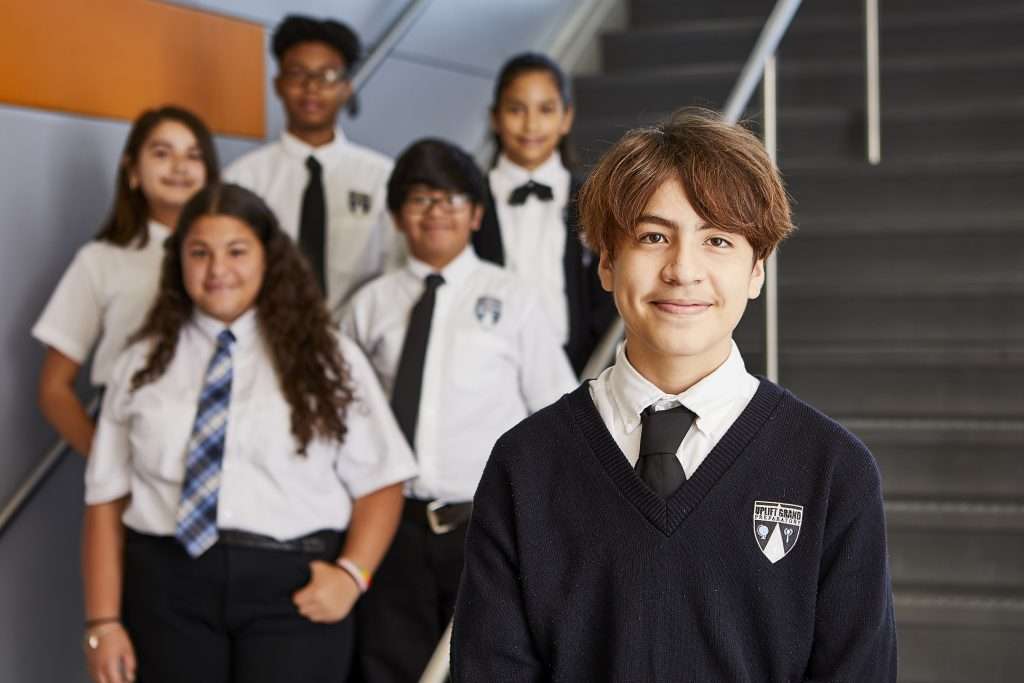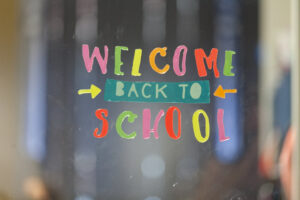The meaning of transition, “the movement, passage, or change from one position, state, stage, concept, to another”, (Dictionary.com), occurs in many different forms for us all. An insect transitions from a caterpillar to a beautiful butterfly, plants transition from seeds, water and sunshine to blooming flowers, construction projects on paper transition from concrete to houses and buildings; but humans transition throughout their lives, beginning first with birth. For humans we call them milestones, starting as infants transition to toddlers, kids, teenagers, and then adults. Although most transitions occur naturally, a transition from elementary to middle school and then middle school to high school may be a challenging time for some because it often involves school, personal social and emotional changes also.
In primary school, even though students have the opportunity to interact with many different teachers throughout their day, they usually only have one or two primary teachers for the majority of their day. In addition, kids create strong and familiar ties to that group of friends in class since they usually stay together the entire school day. When our kids transition and move to middle school, they have a different structure that reflects the instructional content delivery with teachers being more like specialists rather than generalists.
Students go from one to two teachers in primary school to a different one for each subject area in middle school. They all of a sudden have students from other ‘feeder’ schools and have to get comfortable and interact with many new faces and cultural and social perspectives. Because of the small amount of time spent in each class in middle school, students don’t have the same opportunity to build those strong relationships with their teacher and other kids the same way as primary and less extracurricular time spent outside with friends either. Students now have to adapt to multiple teaching styles, different teacher expectations and rules, different classroom styles, as well as different grading standards depending on the class and teacher also.
We know that when students come to Uplift for middle school, it is a huge adjustment because now students will have eight teachers, multiple groups of students in their classes, and they only spend 90 minutes in each class every other day. We help our 6th grade students transition by providing a two-day transition camp, where we focus primarily on community building, fostering relationships, and establishing strong connections to all teachers. We solidify routines, create class agreements, and ensure that each 6th grader feels known and understood by all their teachers, peer-to-peer relationships, clubs, personal identity, school identity.
The 5th to 6th grade transition is a huge jump for students and parents, but once the 6th graders are here in middle school, their developmental growth is lightspeed. Uplift supports our students and families coming into 6th with understanding the big increase in responsibility and independence. Our work with SEL, Restorative Practices, and the IB Learner Profile Traits are essential because we teach our students that with independence comes the challenge of making positive and negative choices, especially when nobody is looking, and when any harm is done or trust is broken, students engage in restorative activities that restore that harm and rebuild trust, whether it’s with another student, with a teacher, or with the greater community. Ultimately, the transition from 5th to 6th grade is about learning how to navigate more choices and more freedoms and how to learn from the mistakes, wins, ups, and downs along the way.
Transition from middle to high school has a huge impact and changes in academic requirements to more demanding coursework, social dynamics and career and college exploration. Getting better organized with agendas and time management is key for students. Courses in high school are often more demanding than in middle school, and students assume greater responsibility for learning content, taking their own notes and completing assignments on time.
One of the challenges of the transition to high school is that things are more permanent and lasting, and that’s a first for many students. Up through the 8th grade, passing classes, course credits, GPAs, even test results – they stay with you, they travel with you. Things are cumulative. “The buck stops here” is a phrase we hear a lot, and that is very different from the lower grades.
On the engagement side, Uplift Academic Director tells the students every year that really engaging in school is the best way to make it work. Engage in class, speak up, ask questions, answer questions – lean into the whole school experience. Get to know other students, get to know the adults! All of that makes a huge impact on the transition, and the enjoyment, of the high school experience.
Another way for kids to connect is to join one or two clubs or participate in an extracurricular activity during or after school, going to school sporting events which help to create a strong sense of belonging. Help your child think through how they are going to balance classes, homework, after-school activities, social life and relaxation. This will set them up for success in the future for college and life.
The 9th grade transition is also a huge time for student self-reflection and answering, “who am I and what am I good at”. Uplift created the first 8 days of school advisory lessons that cover a lot of topics that help ease this transition.
At Uplift, we focus on helping to develop the whole child. From the day families choose to send their child to Uplift until they graduate and continue to higher education or a career. To better help children transition from primary to middle schools and high school Uplift offers transition camps. Transition camps begin two days before the school year to help children gradually learn about their new campus, teachers, school rules, find their lockers and really get comfortable within their environment. Students entering new grade levels or entering the district are invited to attend transition camps.
The Uplift student experience culminates in the high school years as they build on the academic and enrichment experiences from primary and middle school. The Road to College & Career (RTCC) team seeks to ensure that every student and their family are prepared, empowered, and supported during their K-12 experience and equally prepared, empowered, and supported as they embark on their chosen post high school pathway. Students begin to interact with the RTCC team at their school to obtain academic support in with high school graduation requirements, career exposure opportunities, and guidance and support with planning their path after Uplift as early as 8th grade. This hands-on assistance takes a variety of forms but often includes individualized support with college and financial aid applications, resume guidance, and early career advising. Upon high school graduation, students join the Uplift Alumni Network where they have access to a team of professionals that are available to support them while navigating their chose postsecondary pathway and ensure that they graduate from college and/or embark on a career that will lead to a choice filled life.
An example of Uplift’s connection with our kids was right before last year’s senior graduation, some of our Primary teachers threw a party for a little over 40 kids here – who had all been here long enough to be taught by them. Kids who’ve been here since kindergarten, now graduating high school, got to go back and relive some of their favorite memories with their primary teachers. That is so special.





